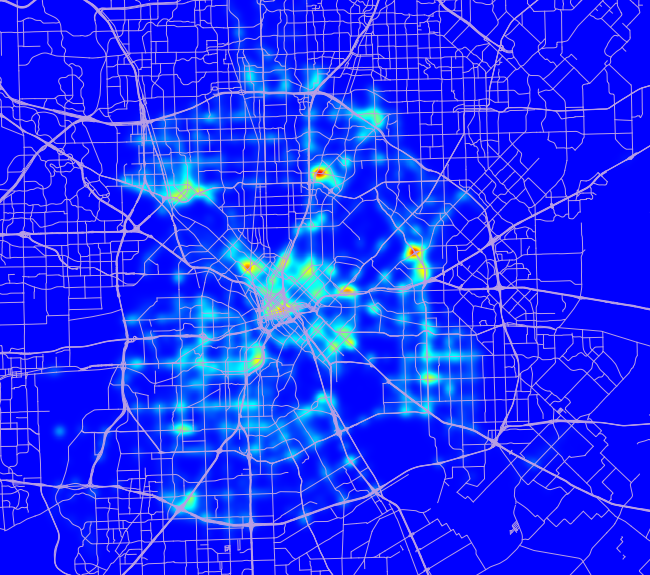Wondering where most traffic ticket are written in Dallas? The below heatmap is from a dataset that includes Dallas (city) tickets 2004-2012 and Dallas County tickets 2006-2012. (Beginning and end years are partial.)
I am assembling this dataset for my in-progress doctorate. (I am a doctoral candidate.)

A couple of notes to help interpretation:
- This is for all officer-written traffic tickets: speeding, red light running, paperwork violations, equipment violations, etc.
- Does not include:
- Tickets unrelated to traffic, like disturbing the peace or drug possession.
- Parking tickets.
- A modest % of tickets that I could not geocode due to no address, bad address data, or limitations of my geocoder.
- Portions of Dallas outside Dallas County.
- Tickets written by other jursdictions. I left out Texas Department of Public Safety because they have hardly any activity in Dallas County except for NTTA freeways. Dallas heavily patrols the NTTA-owned Mountain Creek Lake Bridge, however!
- Tickets sent directly to county courts instead of municipal or JP courts, like DUI.
- Automated ticketing machines like Dallas’s red light cameras.
- This may modestly understate Dallas County sheriff and constable tickets because I have about 2 more years of Dallas city tickets in here.
I find it surprising that the most significant traffic enforcement activities are generally not along major roadways, but rather are in areas of town commonly perceived as dangerous.
Two huge peaks are at the Five Points area (Park Ln. east of US 75) and Ferguson/Buckner. Other obvious areas of emphasis:
- Downtown
- Maple and Wycliff
- Just north of Bachman Lake
- Pleasant Grove
- Oak Cliff
- Fair Park
- North Skillman
- Red Bird area
It’s as if traffic enforcement is largely being used as a pretext for arrests and searches that might otherwise be difficult to pass constitutional muster. That may be interesting as commentary, but it is not a focus for my research. I’m really focucing on the safety effect of enforcement.
There is an apparent focus on intersections, although it’s possible that this is an artifact of officers writing in the nearest intersection for the ticket’s address.
Interesting. I try to live in a world where the vast majority of law enforcement do the right thing, the vast majority of the time. It keeps my world sane. If traffic violations are slightly higher and enforcement works in denser concentrations in areas known for a higher crime rate, it follows that law enforcement will be presented with more “probable cause” situations that lead to arrests or tickets for non-traffic violations. Much like the stop and frisk policy in New York has reduced crime and removed thousands of weapons from the streets, strict enforcement of basic traffic laws may lead to safer neighborhoods. Bogus stops and bogus searches without probable cause are abhorrent to our system of justice and hopefully as rare as my world construct allows. If the system is way more corrupt than that, it is doubtful law enforcement needs a pretext to stop someone. They can just make up the reason, if they really want to stop someone. The fact is, most traffic violations are symptoms of something else happening in the car and sometimes the police have the right to discover what that something else is. Nothing to see here, keep moving.
The conclusion could likely be “Police Officers are primarily focused on high-risk areas, on more serious crimes than traffic violations. The police’s focus on the ‘bad parts of town’ results in them spending more time in those parts of town. Since that’s where the police are, that is where a majority of the traffic violations are seen, and enforced. The police do not appear to be using traffic violations as a revenue generating opportunity, and instead are more focused on general public safety.”